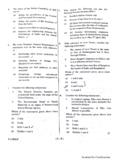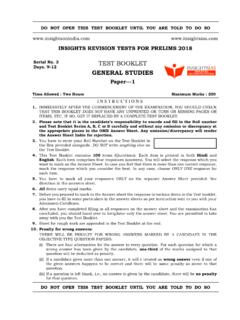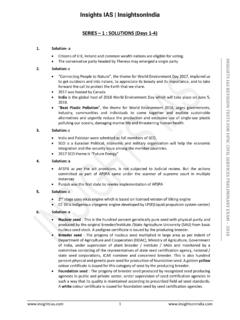Transcription of SIMPLIFYING IAS EXAM PREPARATION
1 INSIGHTSIAS SIMPLIFYING IAS EXAM PREPARATION | INSIGHTS ACTIVE LEARNING - I A S S E L F S T U D Y G U I D E - STATIC QUIZ Indian History India & World Geography Indian Polity & Governance Series I INSIGHTS QUIZ ON STATIC SYLLABUS 1 INSIGHTS ACTIVE LEARNING INSIGHTS QUIZ ON STATIC SYLLABUS INSIGHTS ACTIVE LEARNING 2 INDEX 1. INDIAN HISTORY _____ 3 2. INDIA & WORLD GEOGRAPHY _____ 18 3. INDIAN POLITY & GOVERNANCE _____ 35 INSIGHTS QUIZ ON STATIC SYLLABUS 3 INSIGHTS ACTIVE LEARNING 1. INDIAN HISTORY 1. Consider the following statements: 1. Brahmanism emphasizes on the rites performed by, and the status of priestly class 2. Brahmanism emerged from Vedanta principles Which of the above statements is/are correct ? (a) 1 Only (b) 2 Only (c) Both 1 and 2 (d) Neither 1 nor 2 Solution: a) Brahmanism, ancient Indian religious tradition that emerged from the earlier Vedic religion.
2 In the early 1st millennium BCE, Brahmanism emphasized the rites performed by, and the status of, the Brahman, or priestly, class as well as speculation about brahman (the Absolute reality) as theorized in the Upanishads (speculative philosophical texts that are considered to be part of the Vedas, or scriptures). In contrast, the form of Hinduism that emerged after the mid-1st millennium BCE stressed devotion (bhakti) to particular deities such as Shiva and Vishnu. The term Brahmanism is considered synonymous with Hinduism, by some scholars. Others consider the transition from ancient Brahmanism into schools of Hinduism that emerged later as a form of evolution, which happened imperceptibly, and one that preserved many of the central ideas and theosophy in the Vedas, and synergistically integrated new ideas.
3 [8] Of the major traditions that emerged from Brahmanism are the six darshanas, particular the Vedanta, Samkhya and Yoga schools of Hinduism. 2. Pratyak a (perception), anum a (inference) and abda ( ptavacana, word/testimony of reliable sources) are accepted as the only reliable means of gaining knowledge in which of the following schools of the Hindu philosophy ? (a) Yoga (b) Samkhya (c) Nyaya (d) Both b and c Solution: d) INSIGHTS QUIZ ON STATIC SYLLABUS INSIGHTS ACTIVE LEARNING 4 Samkhya or Sankhya is one of the six stika schools of Hindu philosophy. It is most related to the Yoga school of Hinduism, and it was influential on other schools of Indian philosophy. S mkhya is an enumerationist philosophy whose epistemology accepts three of six pramanas (proofs) as the only reliable means of gaining knowledge. These include pratyak a (perception), anum a (inference) and abda ( ptavacana, word/testimony of reliable sources).
4 Sometimes described as one of the rationalist schools of Indian philosophy, this ancient school s reliance on reason was exclusive but strong. The Nyaya school holds that there are four valid means of knowledge: perception (pratyaksha), inference (anumana), comparison (upamana), and sound, or testimony (shabda). Invalid knowledge involves memory, doubt, error, and hypothetical argument. 3. Which of the following schools of thought maintained that though events (dharmas) have only momentary existence, there is a transmigrating substratum of consciousness that contains within it seeds of goodness that are in every person ? (a) Sautr ntika (b) Sammitiya (c) Vaisheshika (d) None of the above Solution: a) This was asked in CS Prelims 2017 in different form. Sautr ntika, ancient school of Buddhism that emerged in India about the 2nd century BC as an offshoot of the Sarv stiv da ( All-Is-Real Doctrine ).
5 The school is so called because of its reliance on the sutras, or words of the Buddha, and its rejection of the authority of the Abhidharma, a part of the canon. The Sautr ntikas maintained that though events (dharmas) have only momentary existence, there is a transmigrating substratum of consciousness that contains within it seeds of goodness that are in every person. The Sautr ntika sometimes is characterized as a transitional school that led to the development of the Mah y na tradition, and many of its views influenced later Yog c ra thought. 4. The major form of Buddhism practised in Tibet, China, Korea, and Japan is (a) Theravada (b) Vajrayana (c) Mahayana (d) Hinayana INSIGHTS QUIZ ON STATIC SYLLABUS 5 INSIGHTS ACTIVE LEARNING Solution: c) The Mah y na tradition is the largest major tradition of Buddhism existing today, with of practitioners, compared to for Theravada and for Vajrayana in 2010.
6 In the course of its history, Mah y na Buddhism spread from India to various other South, East and Southeast Asian countries such as Bangladesh, Nepal, Bhutan, China, Taiwan, Mongolia, Korea, Japan, Vietnam, Indonesia, Malaysia and Singapore. Mahayana Buddhism also spread to other South and Southeast Asian countries, such as Afghanistan, Thailand, Cambodia, Laos, the Maldives, Pakistan, Sri Lanka, Burma, Iran and other Central Asian countries before being replaced by Theravada Buddhism or other religions 5. With reference to Avalokiteshvara, consider the following statements: 1. Avalokiteshvara is a divine and compassionate depiction of Jina in certain parts of coastal Karnataka 2. Avalokiteshvara is the earthly manifestation of the self-born eternal Amitabha (another name for Bahubali) Which of the above statements is/are correct?
7 (a) 1 Only (b) 2 Only (c) Both 1 and 2 (d) Neither 1 nor 2 Solution: d) Source: AN INTRODUCTION TO INDIAN ART NCERT Avalokiteshvara, (Sanskrit: avalokita, looking on ; ishivara, lord ) Chinese (Pinyin) Guanyin or (Wade-Giles romanization) Kuan-yin, Japanese Kannon, in Buddhism, and primarily in Mahayana ( Greater Vehicle ) Buddhism, the bodhisattva ( buddha-to-be ) of infinite compassion and mercy, possibly the most popular of all figures in Buddhist legend. Avalokiteshvara is beloved throughout the Buddhist world not only in Mahayana Buddhism but also in Theravada ( Way of the Elders ), the branch of Buddhism that largely does not recognize bodhisattvas, and in Vajrayana ( Diamond Vehicle ), the Tantric (or Esoteric) branch of Buddhism. Avalokiteshvara, Padmapani, Vajrapani,. Amitabha, and Maitreya Buddha are all Boddhisattvas.
8 6. Consider the following statements: 1. Animism believes that even objects have objects and places possess a distinct spiritual essence 2. Jainism s philosophical roots can be traced to animism INSIGHTS QUIZ ON STATIC SYLLABUS INSIGHTS ACTIVE LEARNING 6 Which of the above statements is/are correct? (a) 1 only (b) 2 Only (c) Both 1 and 2 (d) Neither 1 nor 2 Solution: a) Animism is the religious belief that objects, places and creatures all possess a distinct spiritual essence. Potentially, animism perceives all things animals, plants, rocks, rivers, weather systems, human handiwork and perhaps even words as animated and alive. There is no proof that philosophy of Jainism or Buddhism have roots in animism. 7. With reference to Shaktism, consider the following statements: 1. It is a major tradition of Buddhism 2.
9 It considers metaphysical reality as feminine Which of the above statements is/are correct? (a) 1 Only (b) 2 Only (c) Both 1 and 2 (d) Neither 1 nor 2 Solution: b) Shaktism (Sanskrit: kta ,; lit., doctrine of energy, power, the Goddess ) is a major tradition of Hinduism, wherein the metaphysical reality is considered feminine and the Devi (goddess) is supreme. It includes a variety of goddesses, all considered aspects of the same supreme goddess. Shaktism has different sub-traditions, ranging from those focussed on gracious Lakshmi to fierce Kali, and some Shakti sub-traditions associate their goddess with Shiva or Vishnu. 8. Consider the following statements: 1. Theravada Buddhism is strongest in Sri Lanka, Cambodia, Thailand, Laos and Myanmar 2. Theravada school of Buddhism believes that it has remained closest to the original teachings of the Buddha Which of the above statements is/are correct?
10 (a) 1 Only (b) 2 Only (c) Both 1 and 2 (d) Neither 1 nor 2 INSIGHTS QUIZ ON STATIC SYLLABUS 7 INSIGHTS ACTIVE LEARNING Solution: c) Theravada Buddhism is strongest in Sri Lanka, Cambodia, Thailand, Laos and Burma (Myanmar). It is sometimes called Southern Buddhism . The name means the doctrine of the elders the elders being the senior Buddhist monks. This school of Buddhism believes that it has remained closest to the original teachings of the Buddha. However, it does not over-emphasise the status of these teachings in a fundamentalist way they are seen as tools to help people understand the truth, and not as having merit of their own. 9. Consider the following statements: 1. The Mathur school was contemporaneous with the school of Gandhara art 2. The material used in Mathura school of art was green phyllite and gray-blue mica schist Which of the above statements is/are correct?









